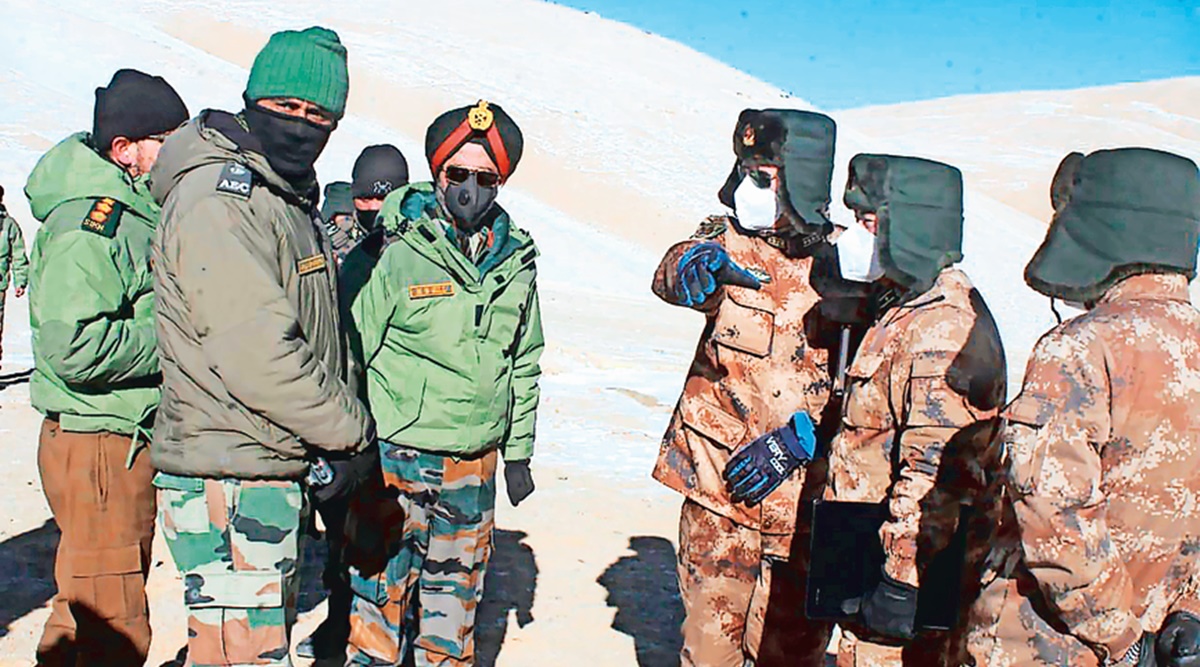 Indian Army and Chinese officers at a meeting in the Pangong Lake region. (Indian Army via AP)
Indian Army and Chinese officers at a meeting in the Pangong Lake region. (Indian Army via AP) A day after New Delhi confirmed the start of the disengagement process at Pangong Tso as a first step to resolve the nine-month military standoff in Ladakh, Army chief General MM Naravane cautioned against Beijing’s recent moves, including along the Line of Actual Control, which “have created an environment of confrontation and mutual distrust”.
Addressing the joint annual seminar of the Assam Rifles and United Services Institution — excerpts of the keynote address Friday were made available to the press — General Naravane said: “The rising footprints of China in India’s neighbourhood and its attempts to unilaterally alter the status-quo along our disputed borders have created an environment of confrontation and mutual distrust.”
He said the regional security environment is “characterised by Chinese belligerence in the Indo-Pacific, its hostility towards weaker nations and relentless drive to create regional dependencies through initiatives like the BRI (Belt and Road Initiative). The resultant Sino-US rivalry has created regional imbalances and instability”.
Speaking at the seminar on ‘Evolving security challenges in the North-East and Way Forward’, the Army chief underlined: “Growth and development are intricately linked to the security environment. Nowhere has this linkage been more profound than in the North-East region.”
Calling it the centre of gravity for sub-regional connectivity and the launch pad for Act East initiatives, he said the region, although endowed with natural resources, is “a laggard in terms of growth and development”.
“Protracted insurgencies, legacy issues further accentuated after Partition and inefficient integration with rest of India account for much of what the region faces today,” he said.
“The impact of the pandemic and the ongoing security dynamics across our borders have brought about significant changes in the geo-strategic construct. It is in this evolving environment that a review and renewed focus on India’s North-East is in order,” he said.
On the neighbourhood, the Army chief said: “Nepal, our traditional long term partner, which has witnessed heavy Chinese investment, is going through a period of political volatility. While Bhutan has been cautious in its approach, we have seen an upswing in our relations with Bangladesh.”
“India is celebrating Swarnim Vijay Varsh to commemorate its splendid victory over Pakistan in the 1971 War for Liberation of Bangladesh. The sight of the Tri-Service Contingent from Bangladesh marching down Rajpath on Republic Day bodes well for our future relations, although growing radicalisation in society remains a serious concern.”
He said “the ongoing dynamics in these neighbouring countries directly impacts the security environment in India’s North-East. A large number of initiatives are already underway to leverage military diplomacy with our Eastern Command playing the spring-board for fostering stronger bilateral relations.”
Regional and internal connectivity, he said, is acutely linked to security and is central to unleashing the potential of the North East and balancing the influence of China. “With failure to deliver on promises, Delivery Deficit has plagued our efforts at improving regional connectivity. The Kaladan Multimodal Transport Project and the Trilateral Highway have both seen cost and time overruns.”
“On the internal front also, infrastructure development has been marred by numerous challenges. Multiple agency involvement and varied sources of funds coupled with environmental factors remain major stumbling blocks. There is a need for an apex body to coordinate multi-agency efforts,” he said.
Pointing to “encouraging improvement” in the internal security situation in the region, General Naravane said Mizoram, Tripura, Meghalaya and large parts of Assam are practically free from insurgency. Violence levels have also gone down significantly over the years. “While relentless operations by the security forces and proactive government policies have laid the foundation, favourable external environment with Myanmar and Bangladesh has struck at the roots of the insurgent organisations.”
He said a series of operations under Operation Sunrise with the Myanmar Army has led to growing cooperation and synergy between soldiers on the ground with “reasonable operational dividends”.
“The situation in most areas has progressed towards conflict resolution,” and consequently, the Army “has also undertaken transition from CI (Counter Insurgency) to Integrated CI approach”.
“Force calibration with gradual disengagement from CI/CT operations has resulted in greater focus towards Northern Borders and the IMB,” he said — IMB is the Indo-Myanmar Border and CT is Counter Terror operations.
He said “force calibration has already resulted in disengagement of 14 Infantry Battalions” and two division headquarters that were part of the CI grid earlier, “are now solely focusing on their operational role along the Northern Borders”. Calling it a “significant achievement” he noted that the operational responsibility of those areas has now been taken over by the Assam Rifles.
To unleash the potential of the North-East, he said there is “need for establishing an organisation that can synergise multi-agency coordination and optimise resource and effort. The Realigned Strategy for the North East proposes a robust and effective N-E Integrated Security Council. With the Minister of State for Home as the Chairman at the apex level, the organisation seeks to galvanise the efforts of all stakeholders which includes the policymakers as well as the authorities responsible to execute these policies”.
“The Army with its wide footprint across the region is ideally suited to play the coordinator. The organisation will address operational and strategic issues and ensure coordinated multipronged response at the regional level,” he said.